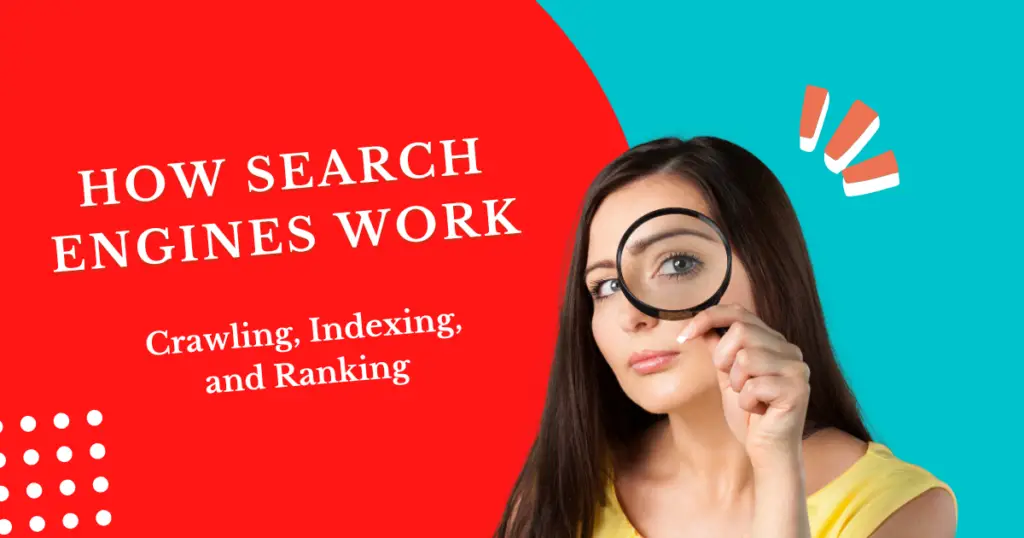How Search Engines Work: Crawling, Indexing, and Ranking
In today’s digital world, understanding how search engines work is crucial for anyone looking to improve their online visibility. Whether you’re a business owner, content creator, or SEO enthusiast, knowing the mechanics behind search engine crawling, indexing, and ranking can help you optimize your website for better search performance.
Search engines like Google, Bing, and Yahoo use complex algorithms to organize and present relevant results to users. But before a website appears on search engine result pages (SERPs), it must go through three essential stages: crawling, indexing, and ranking. Let’s break down each step with real-world examples to help you grasp the process more effectively.
1. What is Search Engine Crawling?
Search engine crawling is the first step in how search engines discover new and updated web pages. This process is carried out by automated bots called search engine spiders or search engine bots (like Googlebot). These bots navigate the web by following links from one page to another, collecting data about each webpage they visit.
How Crawling Works?
Think of search engine bots as librarians gathering books for a digital library. When a librarian discovers a new book, they scan its pages, understand its content, and decide where to place it in the library. Similarly, search engine spiders scan websites, analyze their content, and store relevant details for indexing.
Example of Crawling in Action
Imagine you publish a new blog post about “Best SEO Practices for Beginners.” If another website already indexed by Google links to your article, Google’s bots will follow that link, crawl your new page, and gather information.
However, if your website has poor internal linking, search engines might struggle to discover all your pages. This is why internal linking and submitting a sitemap via Google Search Console is essential for effective crawling.
How to Ensure Your Site is Properly Crawled?
- Create and submit an XML sitemap to Google.
- Use robots.txt to guide search engine crawlers on which pages to crawl.
- Optimize your internal linking structure.
- Regularly update your website with fresh content.

2. What is Search Engine Indexing?
Once a page is crawled, the next step is search engine indexing. This is when the search engine stores and organizes the information it has gathered, making it available for users in search results.
If crawling is like a librarian scanning a book, indexing is the process of categorizing and storing it in the right section so that readers (search users) can find it easily.
How Indexing Works?
Search engines analyze the content of a webpage to determine its relevance for specific search queries. Factors like keywords, metadata, structured data, and content freshness influence whether a page gets indexed.
Example of Indexing in Action
Let’s say you write a blog titled “How to Optimize Images for SEO.” Once crawled, search engines analyze your content for relevant terms like:
- Image SEO
- Optimizing images for search engines
- Search engine optimization basics
If your blog is well-structured and relevant, it gets added to the search engine’s index, making it eligible to appear in search results when someone searches for “image SEO best practices.”
Why Some Pages Aren’t Indexed?
- Blocked by robots.txt – If a page is disallowed in robots.txt, search engines won’t index it.
- Noindex Tag – If a page contains a meta noindex tag, it won’t appear in search results.
- Duplicate Content – If the content is too similar to another indexed page, search engines may ignore it.
- Poor Content Quality – Thin or spammy content may be excluded from indexing.
How to Ensure Your Pages are Indexed?
- Use Google Search Console to check for indexing issues.
- Avoid duplicate content and use canonical tags where necessary.
- Improve content quality by making it original, informative, and engaging.
- Optimize title tags and meta descriptions for search relevance.
3. What is Search Engine Ranking?
Once a webpage is crawled and indexed, the final step is search engine ranking—where search engines determine how high your page appears in the search engine result pages (SERPs).
Ranking is based on search engine algorithms, which evaluate hundreds of factors to determine the most relevant results for a user’s search. Some key ranking factors include:
- Keyword relevance
- Backlink quality
- User experience (UX)
- Mobile-friendliness
- Website speed
Example of Ranking in Action
Consider two websites with similar articles about “SEO for Beginners.” One website has well-optimized title tags, structured data, and high-quality backlinks, while the other has thin content and slow load times.
Which one do you think will rank higher? The first website, because it aligns with key ranking signals, providing a better user experience and valuable content.
How to Improve Your Search Engine Ranking?
- Optimize for User Intent – Ensure your content matches what users are searching for.
- Use Targeted Keywords Naturally – Avoid keyword stuffing and focus on high-intent keywords like “how search engines rank websites” and “search engine optimization basics.”
- Build Quality Backlinks – Earning high-quality backlinks from authoritative sites boosts credibility.
- Enhance Page Speed & Mobile-Friendliness – Optimize images, enable caching, and use a responsive design.
- Encourage Engagement – The longer users stay on your page (dwell time), the better your chances of ranking higher.
Key Takeaways
- Crawling: Search engine bots discover your web pages by following links. Ensure your site is accessible and well-structured.
- Indexing: Once crawled, search engines store your content in their database. Avoid blocking important pages from being indexed.
- Ranking: Indexed pages are ranked based on relevance, backlinks, speed, and user experience. Optimize your site with best SEO practices.
By implementing these SEO strategies and optimizing your site for search engine crawling, indexing, and ranking, you can improve your online presence and drive more organic traffic. Keep your content updated, use effective keywords, and focus on providing value to users to stay ahead in the ever-evolving world of search engine optimization.



